As a teacher, brain research absolutely fascinates me so much that I went back to school for a graduate degree in brain research. There have been so many new developments over the past several years and the implications for teachers are so powerful. However, it’s incredibly easy to get lost in the technical details, so I’ve written a post that shares six common myths about the brain. I’ve also shared what that means for us as teachers.
If you love learning about this topic, I highly recommend any of the books below. They go into to great detail with the whys and hows of cognitive science.
Myth 1-Our Brain is Designed to Think
Most people are surprised to learn that the brain is not designed for serious thinking. Instead, it’s designed to save you from having to think, because thinking is slow and unreliable. It’s uncomfortable for your brain to have to use energy to work through something new and different. It requires concentration and resources the brain would rather not use.
I remember the last time my printer broke, and I tried to read the manual to trouble shoot. It was as if my brain completely shut down. It did NOT want to work on that darn printer. I was seriously ready to just pay for a new one, rather than fix the old one. My brain did NOT want to think about printers, toner, and networks.
Rather than thinking, the brain often relies on memory. Most of the problems we face are ones we’ve solved before, so we typically do what we’ve always done. For example, when we drive home from school, we don’t think about every single action and decision. It’s as if we’re on autopilot, which is because we’re using memory.
However, most people enjoy solving problems. Solving a problem brings us pleasure. However, working on a problem unsuccessfully is quite the opposite. It’s frustrating. On the other hand, immediately knowing the answer to a problem does not bring problem solving pleasure, either. Imagine if you went to an escape room, but someone had already told you where to find all of the clues and the solution to all of the codes. “Escaping” wouldn’t be much of a thrill. The fun is in the solving.
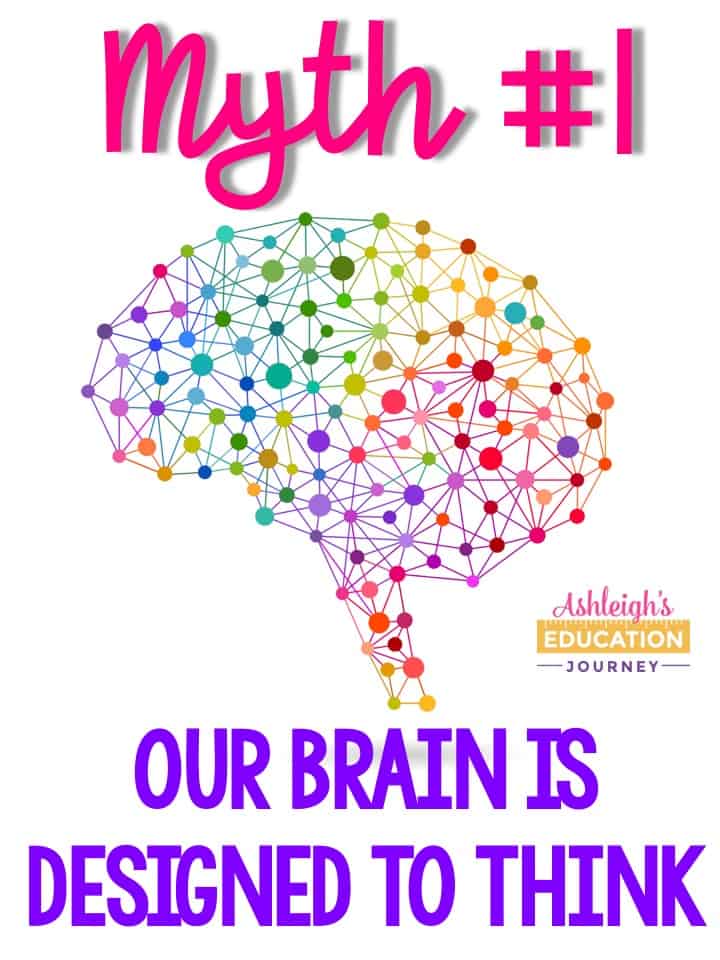
What does this mean for me as a teacher?
- We have to give our students a problem to be solved. This isn’t the same as answering questions on a worksheet. It needs to be a real problem.
- If a students’ classwork is too difficult or too easy, then the student will likely not enjoy problem or task. We have to keep in mind our students’ cognitive abilities and adapt their work accordingly.
- Avoid overdoing students’ working memory. Working memory has limited space, so thinking becomes difficult when the working memory is crowded. To help students, write notes on the board or provide handouts to free working memory space.
- Focus on timing. You have to evaluate each task to determine when to introduce the problem to students. Will you begin the lesson with the problem, or will you teach general information to give students background understanding first?
Myth 2-It’s Not Important to Learn Facts
It is absolutely true that facts without skills to apply them are not beneficial. But, it is also true that students cannot apply thinking skills without factual knowledge. In fact, skills such as analyzing and critical thinking require extensive factual knowledge. Factional knowledge is important to:
- understand the connection between ideas
- allow the brain to chunk information, in order to free working memory space
- provides vocabulary
- improve memory and memory cues
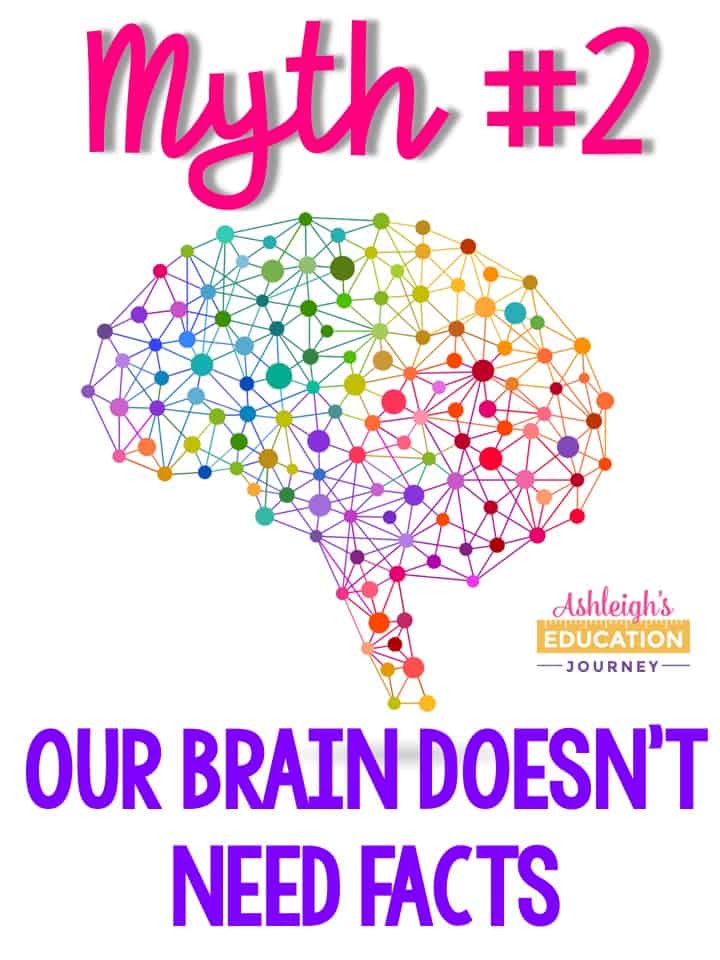
What does this mean for me as a teacher?
Memorizing facts and information sometimes gets a bad rap, but it’s important to remember that factual knowledge is still important for learning. We obviously can’t teach ALL the facts. So, the real challenge comes from determining which facts are most important for students to learn and the best ways of sharing this information with students. Most students gain the bulk of their factual information from experiences, exposure, and reading.
Myth 3-The Brain Records Everything
It’s not possible for the brain to store everything that we have ever experienced in our memory. It’s just too much. Instead, we remember what we think about.
There is tons of brain research specific to working memory and long term memory, and I won’t get into all of that information here. Instead, I’ll try to summarize the main points of that research.
- Events that create an emotional reaction are often well remembered. I can still remember standing outside my kindergarten classroom watching the Challenger launch and then actually seeing it explode. At that age I didn’t get the significance, but it was emotional enough that I still remember it clearly.
- Repetition is also incredibly important for memory. But, not all repetition is effective. How many of us can still remember jingles from commercials we heard years ago?
- Another boost to memory is thinking about the meaning and relationships of words and events.
- The brain is inclined to notice and remember stories.
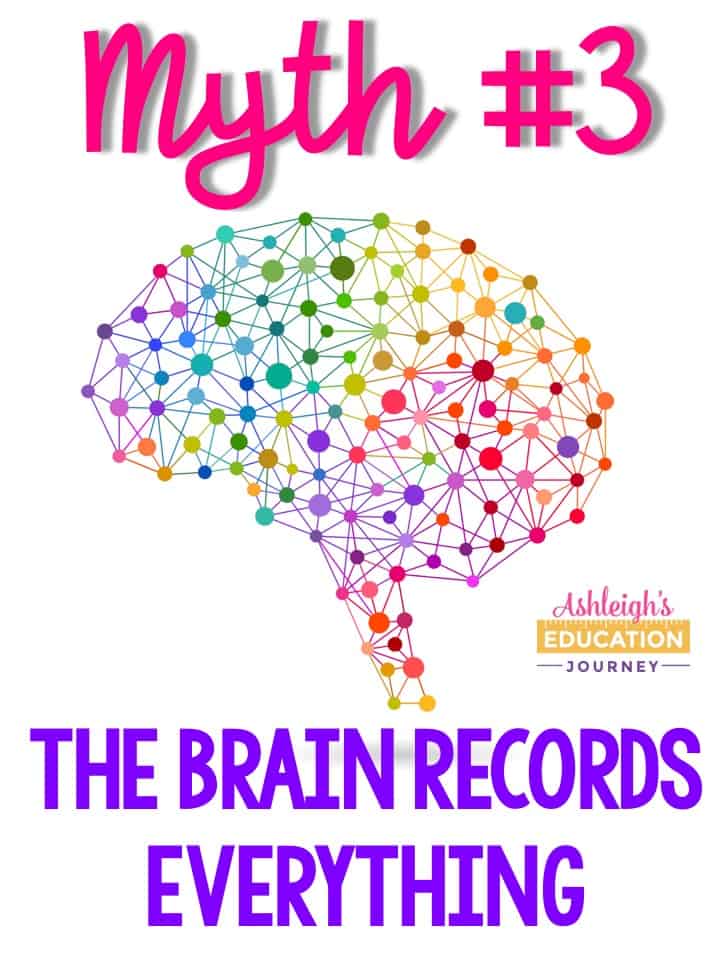
What does this mean for me as a teacher?
We must carefully consider what our assignments will make our students think about, because that is what our students will remember. It’s important to note that it’s not what we want students to think about, but what they will actually think about. Many projects with good intentions fall flat, because students were thinking about the wrong thing.
Teachers should also think carefully about their attention grabbers, because it’s important to hook students early in the lesson so they are curious and want to know more. Finally, we should look for opportunities to organize lessons around conflict, so we can turn the lesson into a story.
Myth 4-The Brain Prefers Abstract Ideas
Brain research shows that the mind prefers concrete ideas, which is why abstract concepts are so challenging for students. As you probably already know, it’s often difficult for students to understand new and novel ideas. These are the ideas that aren’t related to other things students have already learned. This is one of the reasons it’s so important to connect new ideas with old ideas. Every new idea should build upon ideas the student already knows.
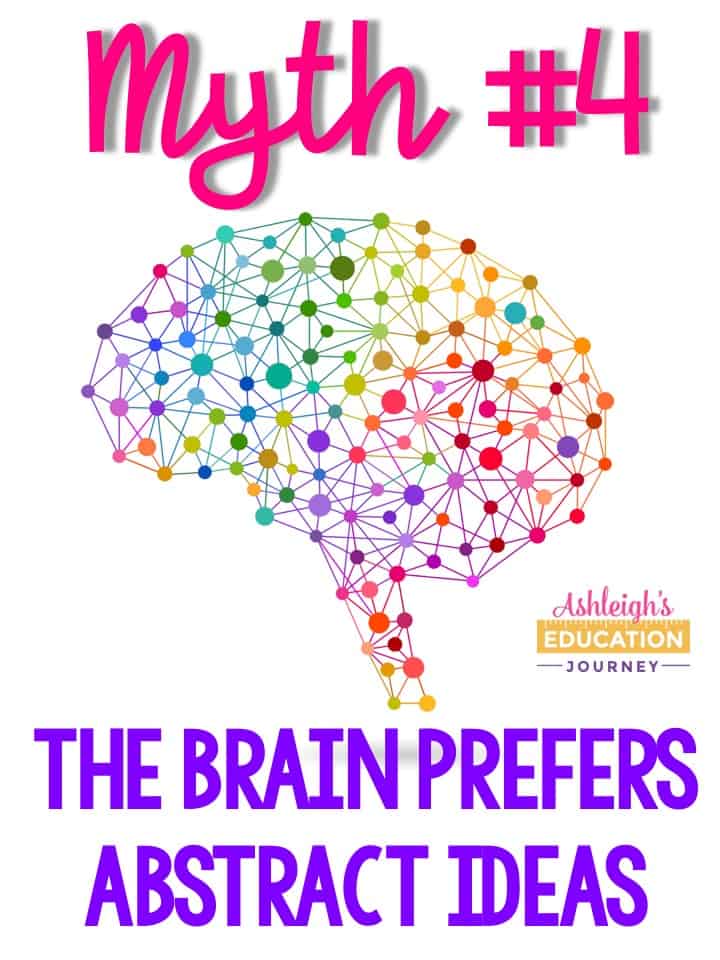
What does this mean for me as a teacher?
- Use analogies to connect understanding.
- Give students familiar concrete examples.
- Have students compare examples of the concepts.
Myth 5-All understanding is the Same
There are different degrees of understanding. We’ve all had students who respond using the exact words you used to explain an idea, and we struggled to tell if the student has simply memorized the definition by rote but without any real understanding or if the student has a deep understanding of the content. One extreme is rote knowledge, which is having no understanding of a topic. This is when a student simply memorizes words or steps to a process.
Shallow knowledge is far more common than rote knowledge. This means that students have some understanding of the material, but their understanding is limited. As mentioned above, students understand new ideas by relating them to old ideas. If their knowledge is shallow, the process stops there. Students can only understand the concept in the context that was provided.
Then, there is deep knowledge, which is when students know more about the topic and the pieces of knowledge connected. When a student has deep knowledge, they understand all parts of the concept and can understand that concept in different contexts.
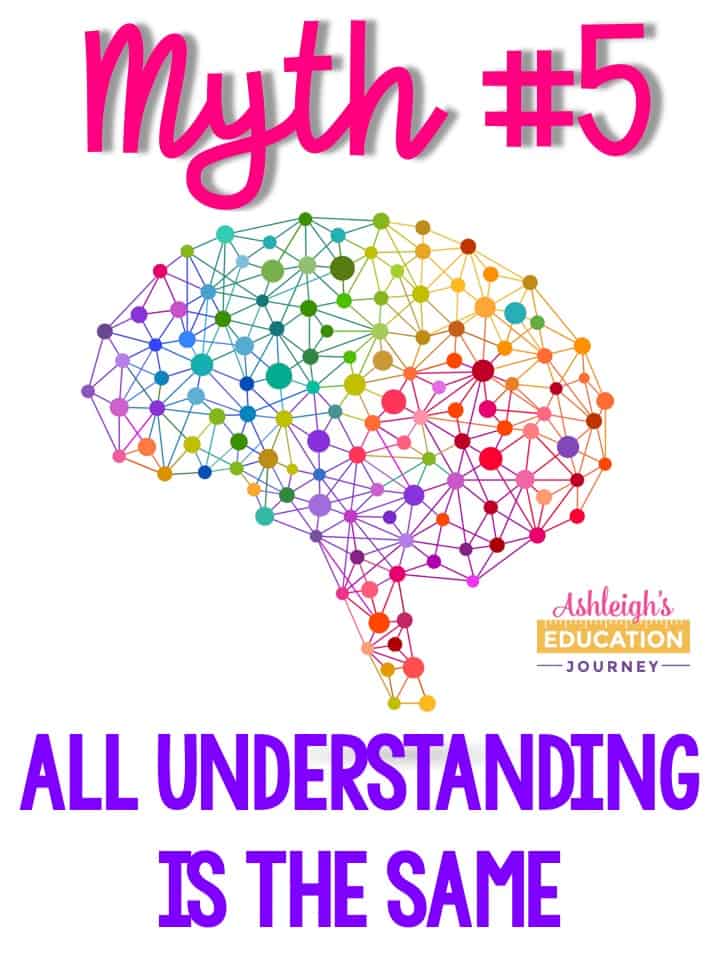
What does this mean for me as a teacher?
When teaching for deep understanding, think about the type of questions you ask in class. If you only ask low-level factual questions, students will likely not think about the deep structure. The same principle also goes for student assignments. While low-level questions and assignments are needed, we must also include tasks or assignments that encourage deep thinking.
It’s also important to keep your expectations realistic. Brain research shows that deep knowledge is challenging and requires time and practice. In many situations, students must obtain shallow knowledge before they can reach deep understanding.
Myth 6-The Mind Can Multi-task
Multitasking is a myth. The human brain cannot perform two tasks that require high-level brain function at once. Low-level functions aren’t considered in multitasking. Low-level processes must become almost automatic to leave room for high-level thinking. This is why practice is so important. In fact, brain research shows it is almost impossible to become proficient at a mental task without practice. There are multiple advantages to practice:
- One reason is to gain a minimum level of competence or to refine skills. For example, a pitcher would need to practice consistently to improve their pitch, or a musician would practice playing their instrument on a regular basis to continue to raise their skill level.
- Practice also enables further learning. Since our working memory space is limited, it is beneficial to automatize mental processes. Automatic process require little to no working memory space, which frees space for new information or processes. This is true with reading (imagine trying to comprehend when having to sound out every single word in a text), math (imagine solving a long division problem when still using fingers to add and subtract basic facts), and writing (imagine having to think about the formation of every single letter as you write an essay). Many processes must become automatic in order for students to advance their thinking to the next level.
- Practice makes memory long lasting.
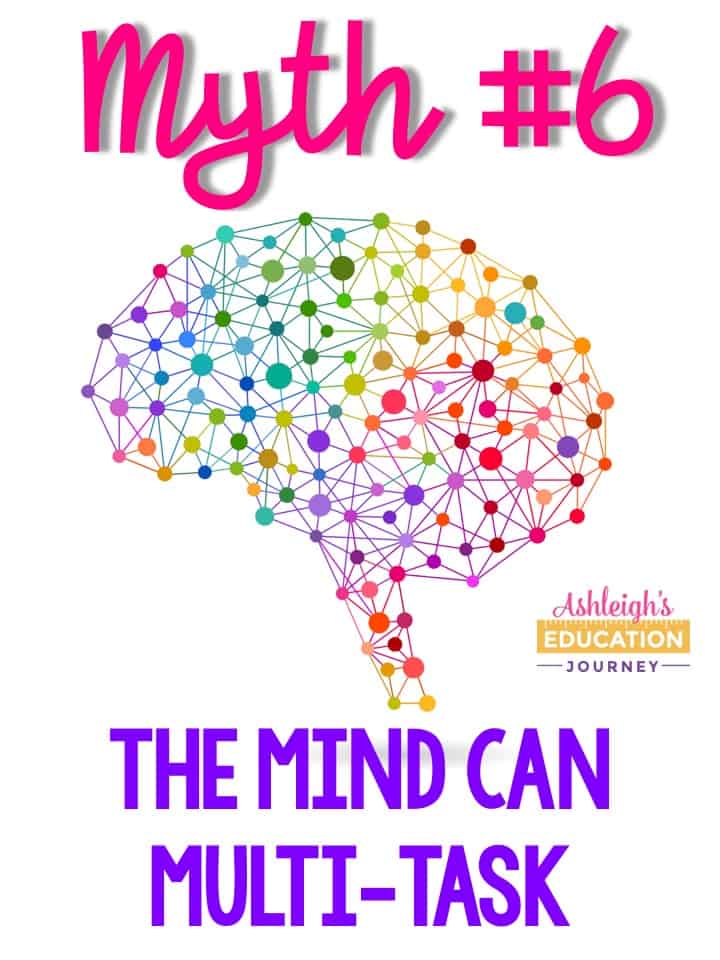
What does this mean for me as a teacher?
There isn’t enough time to practice everything extensively, so we have to think about which process must become automatic for our students. We have to prioritize the skills that will become the building blocks of of new content and skills. We should also space out our practice in order to benefit students’ long-term memory. For example, rather than giving one practice page each day for a week, space out the pages by giving one page a week for five weeks. In that practice, it’s also beneficial to include multiple skills that will require students to think carefully. Practice doesn’t always have to be isolated. It can also be integrated with more advanced skills.
There is one more myth that I’m particularly excited to discuss, but it will need to be its own blog post. I’ll give you a hint: it has to do with learning styles!

This is fascinating! I really appreciate your ideas for how I can apply it as a teacher. Thank you!